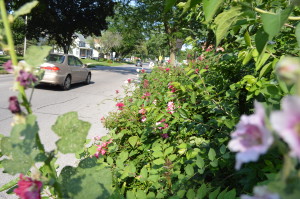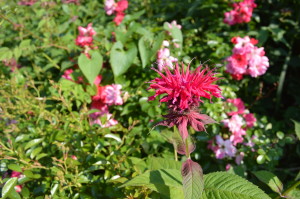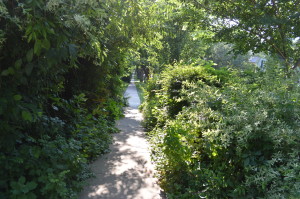
Cars drive past Timothy Volm’s front yard in Iowa City on Friday, July 5, 2013. The city has ordered Volm to remove all of the plantings and replace with a groundcover, such as grass. (photo/Cindy Hadish)
IOWA CITY – Roses, hollyhocks, bee balm and numerous other plants grow harmoniously in Timothy Volm’s front yard, but the lush vegetation is creating dissonance with the city.
Volm has been ordered to remove all of the plants by Tuesday, July 9, 2013, or city staff will clear the site and charge the costs to him.
The city notified Volm that a complaint was lodged regarding a sight obstruction for vehicles and passage on the sidewalk of his Church Street home. He was ordered to remove the plants so they do not grow back in the future and replace with grass or another groundcover.
Volm said the only driveway near his house is used by a neighbor who is supportive of his front-yard garden.

Bee balm and roses are among the flowers growing in the front yard of Timothy Volm’s Church Street home in Iowa City. Volm said he often receives compliments about the plants and an elderly neighbor stops by to pick flowers. (photo/Cindy Hadish)
“I do not know how they can say it obstructs traffic views,” he said, adding that the city’s own plantings elsewhere in Iowa City cause more sight obstructions for drivers than his plants do.
Volm, a doctor, noted his efforts were undertaken for environmental reasons. His plantings require no chemicals and no gas for mowing.
Alternative lawns like his reduce groundwater pollution and carbon dioxide and increase biodiversity, especially among pollinating insects, and are encouraged in progressive communities, including West Des Moines, he said.
Volm often receives compliments about his front yard, where song birds nest and an older neighbor stops by to pick flowers.
If a storm blows plants over the sidewalk, he promptly cuts them back, he said.
After an inspection in June, however, staff determined that all the plants growing within the city right-of-way must be removed, with the exception of three trees: a Bradford pear,
Japanese redleaf maple and an elm.

The sidewalk in front of Timothy Volm’s Iowa City home shows a clear path on July 5, 2013, but city staff said complaints have been lodged against the plantings. (photo/Cindy Hadish)
The letter from Iowa City Parks Superintendent, Terry Robinson, noted “this includes the rosebushes and other plants growing in the first three feet of property behind the sidewalk toward your house which is also City right of way.”
Indicating the issue has been ongoing for five years, Robinson stated that the rosebushes and other plants behind the sidewalk are included in the order “because you have demonstrated the inability to maintain them in a condition so they do not
obstruct passage on the sidewalk.”
Iowa City isn’t the first municipality to engage in disagreements over a homeowner’s “right to garden.”
Nationwide, a number of gardeners – often those growing vegetables or other edibles – have been cited for ordinance violations. Last year, an article in the New York Times referenced disputes from Orlando to Oklahoma.
The story noted that Americans spend an estimated $30 billion annually on lawn care and divert rivers “so those in arid places like Phoenix can spend their Saturdays behind a mower, too.”
Fred Meyer, director of the Iowa City-based non-profit, Backyard Abundance, which helps create landscapes to provide food and habitat, said Volm is rethinking how our right-of-ways and front yards might be more beneficial.
“It is not just an attempt to reform turfgrass by interplanting white clover and violets,” Meyer said, noting Volm is experimenting with a thicket habitat—an ecological oasis known to directly support wildlife and help manage rainwater. “It looks different, but do we really expect environmentally-beneficial landscapes to look similar to conventional turf landscapes?”
Meyer said our culture has a bit of cognitive dissonance when it comes to improving environmental health: we want to reverse the unprecedented rate of species extinction, improve water quality, lessen the use of harmful lawn chemicals, and halt climate change while simultaneously maintaining the “turfgrass status quo.”
“The virtually lifeless areas of energy-dependent, useless turf in front of our houses are great opportunities to overcome this dissonance through experimentation,” he said.
Meyer noted that the Iowa City landscape ordinance primarily promotes safety and ensures people mow their lawns. The Natural Areas exemption demonstrates a desire to improve urban wildlife habitat.
“As more residents join this increasingly popular movement, my sincere hope is that the ordinance will be updated to provide specific design and plant guidelines,” he said.
Volm said he has offered to have his lawn professionally landscaped, but the city has not responded. Eventually, he believes, more homeowners will come to embrace the environmental approach to lawns.
“It will happen, it is just a matter of time,” Volm said. “People and nature need to learn to co-exist. It is the future.”
Related: Keys to drought, flooding and climate change found in our soil

Saddened and outraged! Shared on my page and KCRG…. am available if this homeowner would like help and/or boycott.
Thank you, Heather.
I just saw your website – you have a beautiful farm! I’m sure Mr. Volm appreciates your support!!
He needs to get his Immediate Neighbors to sign a Petion.. FAST!!! And get Info from the Local Agricutural Department on what he needs to do…. So Sad and Outraged for him; and may the person… (I know it was someone who has power in the Community,) have a Tree fall on Their “Own Private Car!!!”
This is outrageous. I understand prohibitions on blocking sight around corners, but otherwise, what purpose is served by ‘preventing’ flowers and other garden items?
Thank you, any help is appreciated. Call elected officials ad let them know how you feel. The city has been unreasonable, and almost comical, in it’s responses. The first year they sent a letter stating that nothing could be ‘planted’ between the sidewalk and street. I felt like pointing out that grass was a plant.
They continue to be unreasonable in their demands.
As is the Volm tradition, Tim is simply a forward thinking individual fighting the good fight against narrow minded bureaucracy!